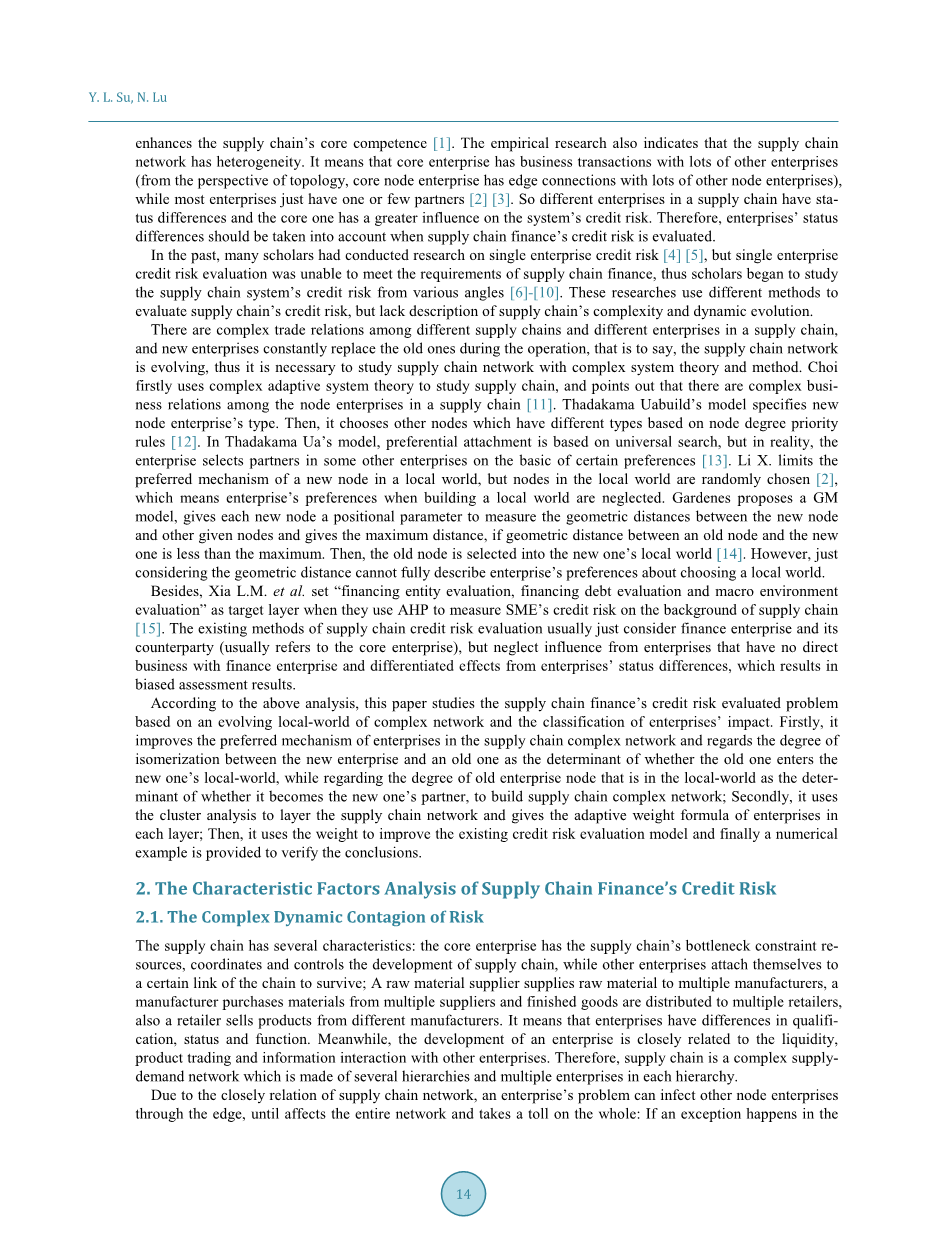英语原文共 9 页,剩余内容已隐藏,支付完成后下载完整资料
Supply Chain Finance Credit Risk Evaluation Method Based on Self-Adaption Weight
1 Abstract
Credit risk is the core issue of supply chain finance. In the supply chain, problems happened in different enterprises can influent the whole to different degrees through transferring, thus statuses of all enterprises and their different influences should be considered when evaluating the supply chainrsquo;s credit risk. We examine the characters of supply chain network and complex network, use the local growing complex network to simulate the real supply chain, use cluster analysis to classify the company into several levels; Introducing each levelrsquo;s self-adaption weight formula according to the companyrsquo;s quantity and degrees of this level and use the weight to improve the credit evaluation method. The research results indicate that complex network can be used to simulate the supply chain. The credit risk evaluation (CRE) of an enterprise level with bigger note degrees has a greater weight in the supply chain systemrsquo;s CRE, thus has greater effect on the whole chain. Considering different influences of different enterprise levels can improve credit risk evaluation methodrsquo;s sensitivity.
2 Introduction
Supply chain finance is a financial service that uses controllable credit risk of the whole supply chain, instead of the uncontrollable credit risk of the SME, to solve SMErsquo;s financing problem. Thus, credit risk is the core issue of supply chain finance and it needs a perfect mechanism to measure the supply chain systemrsquo;s credit risk from a global perspective. Meanwhile, enterprises in the supply chain are divided into core and non-core ones, Lu S.Q. thinks that core enterprise has the supply chainrsquo;s bottleneck constraint resources, decides the smooth operation and performance of the supply chain, organizes division of labor and coordinates resource allocation, forms and enhances the supply chainrsquo;s core competence . The empirical research also indicates that the supply chain network has heterogeneity. It means that core enterprise has business transactions with lots of other enterprises (from the perspective of topology, core node enterprise has edge connections with lots of other node enterprises), while most enterprises just have one or few partners . So different enterprises in a supply chain have status differences and the core one has a greater influence on the systemrsquo;s credit risk. Therefore, enterprisesrsquo; status differences should be taken into account when supply chain financersquo;s credit risk is evaluated.
In the past, many scholars had conducted research on single enterprise credit risk , but single enterprise credit risk evaluation was unable to meet the requirements of supply chain finance, thus scholars began to study the supply chain systemrsquo;s credit risk from various angles . These researches use different methods to evaluate supply chainrsquo;s credit risk, but lack description of supply chainrsquo;s complexity and dynamic evolution.
There are complex trade relations among different supply chains and different enterprises in a supply chain, and new enterprises constantly replace the old ones during the operation, that is to say, the supply chain network is evolving, thus it is necessary to study supply chain network with complex system theory and method. Choi firstly uses complex adaptive system theory to study supply chain, and points out that there are complex business relations among the node enterprises in a supply chain. Thadakama Uabuildrsquo;s model specifies new node enterprisersquo;s type. Then, it chooses other nodes which have different types based on node degree priority rules. In Thadakama Uarsquo;s model, preferential attachment is based on universal search, but in reality, the enterprise selects partners in some other enterprises on the basic of certain preferences . Li X. limits the preferred mechanism of a new node in a local world, but nodes in the local world are randomly chosen , which means enterprisersquo;s preferences when building a local world are neglected. Gardenes proposes a GM model, gives each new node a positional parameter to measure the geometric distances between the new node and other given nodes and gives the maximum distance, if geometric distance between an old node and the new one is less than the maximum. Then, the old node is selected into the new onersquo;s local world . However, just considering the geometric distance cannot fully describe enterprisersquo;s preferences about choosing a local world.
Besides, Xia L.M. et al. set “financing entity evaluation, financing debt evaluation and macro environment evaluation” as target layer when they use AHP to measure SMErsquo;s credit risk on the background of supply chain . The existing methods of supply chain credit risk evaluation usually just consider finance enterprise and its counterparty (usually refers to the core enterprise), but neglect influence from enterprises that have no direct business with finance enterprise and differentiated effects from enterprisesrsquo; status differences, which results in biased assessment results.
According to the above analysis, this paper studies the supply chain financersquo;s credit risk evaluated problem based on an evolving local-world of complex network and the classification of enterprisesrsquo; impact. Firstly, it improves the preferred mechanism of enterprises in the supply chain complex network and regards the degree of isomerization between the new enterprise and an old one as the determinant of whether the old one enters the new onersquo;s local-world, while regarding the degree of old enterprise node that is in the local-world as the determinant of whether it becomes the new onersquo;s partner, to build supply chain complex network; Secondly, it uses the cluster analysis to layer the supply chain network and gives the adaptive weight formula of enterprises in each layer; Then, it uses the weight to improve the existing c
剩余内容已隐藏,支付完成后下载完整资料
资料编号:[139507],资料为PDF文档或Word文档,PDF文档可免费转换为Word
以上是毕业论文外文翻译,课题毕业论文、任务书、文献综述、开题报告、程序设计、图纸设计等资料可联系客服协助查找。




